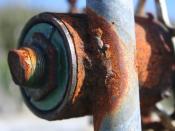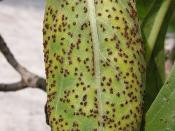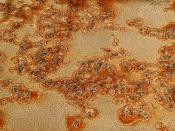The Effects of Bacteria on the Rusting Process As the RMS Titanic soundly rests at the bottom of the frigid, dark waters of the Northern Atlantic, small bacteria and other microorganisms slowly engulf and suppress its once sturdy hull. The iron ship slowly turns a fiery orange color and parts of the ship steadily flake and drift away in the rapid currents of the deep murky water. This process of deterioration where oxygen and iron chemically react to form iron oxide (2Fe2O3), or rust, as it is commonly known, plagues items we use everyday, refrigerators, bikes, and tools, to historical relics like the mighty Titanic, which sank more than 80 years ago.
To fully understand the effects of rust and the possible parts that bacteria may have in the rusting process is a common goal held by scientists and microbiologists. The development of new methods to counter the harsh effects of rust is a project of great magnitude and importance.
If there are any connections between bacteria and the rusting process, then the information gathered from experiments can be applied to various new materials and compounds that will slow the rusting process or eliminate it completely. As more knowledge of bacteria, rust, and the chemical and physical properties held by iron are acquired, there shall be an extensive understanding of whether or not bacteria have an effect on the rusting process.
Discoverer: Unknown Name Origin: Latin Symbol Origin: From the Latin word ferrum (iron) Uses: Steel, hemoglobin (carries oxygen in blood) Obtained From: Iron ores Atomic Number: 26 Atomic Symbol: Fe Atomic Weight: 55.847 Electron Configuration: [Ar]4s23d6 Iron, the 26th element in the periodic table of elements, is a silvery-gray lustrous transition metal. It's widely known for having many uses, the most important being its strong structure and availability, making...


